Management & Organizational Behavior: Technology's Positive Impacts
VerifiedAdded on 2023/06/12
|10
|2611
|342
Essay
AI Summary
This essay explores the positive impacts of technology in the workplace, focusing on management and organizational behavior. It highlights how technology enhances efficiency, creativity, and connectivity among employees, while also improving workplace conditions and employee well-being. The essay discusses the evolution of technology's role, from time clocks to AI-driven systems, and its effects on productivity and employee engagement. It also addresses the integration of social media and personal devices in the workplace, emphasizing the importance of balancing technological advancements with human considerations. The essay concludes that embracing modern technology can transform the workplace, attracting and retaining top talent by creating a more supportive and productive environment. Desklib provides access to similar essays and study resources for students.
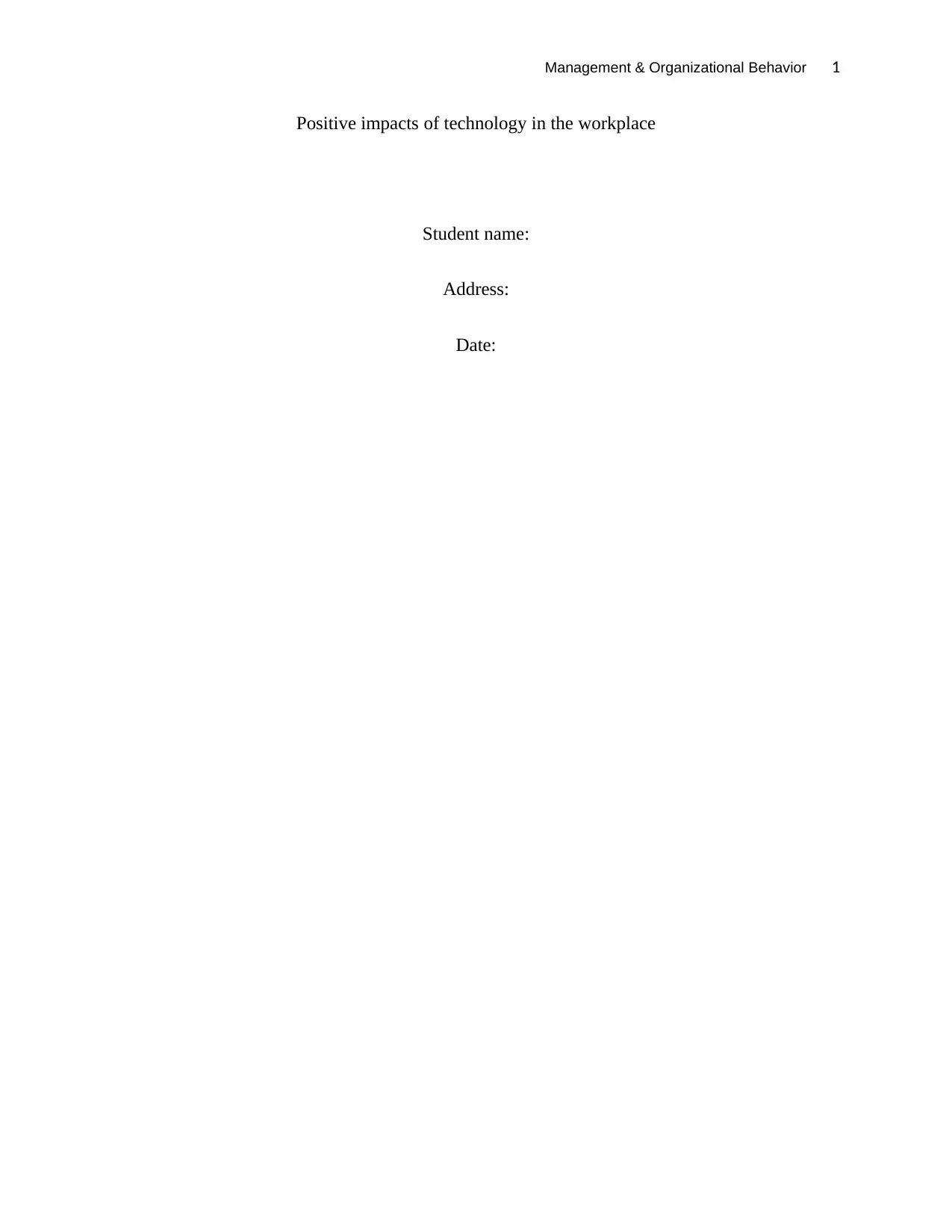
Management & Organizational Behavior 1
Positive impacts of technology in the workplace
Student name:
Address:
Date:
Positive impacts of technology in the workplace
Student name:
Address:
Date:
Paraphrase This Document
Need a fresh take? Get an instant paraphrase of this document with our AI Paraphraser
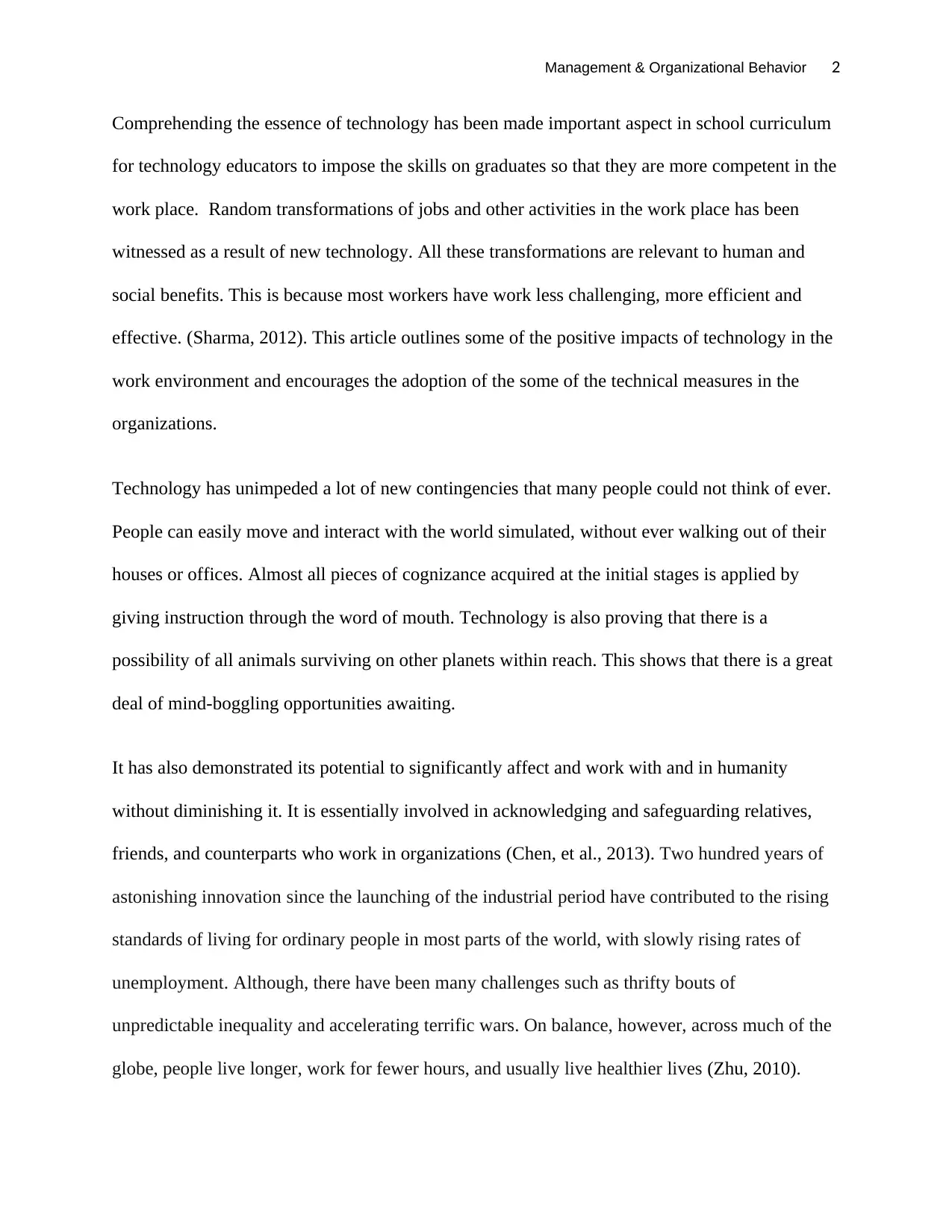
Management & Organizational Behavior 2
Comprehending the essence of technology has been made important aspect in school curriculum
for technology educators to impose the skills on graduates so that they are more competent in the
work place. Random transformations of jobs and other activities in the work place has been
witnessed as a result of new technology. All these transformations are relevant to human and
social benefits. This is because most workers have work less challenging, more efficient and
effective. (Sharma, 2012). This article outlines some of the positive impacts of technology in the
work environment and encourages the adoption of the some of the technical measures in the
organizations.
Technology has unimpeded a lot of new contingencies that many people could not think of ever.
People can easily move and interact with the world simulated, without ever walking out of their
houses or offices. Almost all pieces of cognizance acquired at the initial stages is applied by
giving instruction through the word of mouth. Technology is also proving that there is a
possibility of all animals surviving on other planets within reach. This shows that there is a great
deal of mind-boggling opportunities awaiting.
It has also demonstrated its potential to significantly affect and work with and in humanity
without diminishing it. It is essentially involved in acknowledging and safeguarding relatives,
friends, and counterparts who work in organizations (Chen, et al., 2013). Two hundred years of
astonishing innovation since the launching of the industrial period have contributed to the rising
standards of living for ordinary people in most parts of the world, with slowly rising rates of
unemployment. Although, there have been many challenges such as thrifty bouts of
unpredictable inequality and accelerating terrific wars. On balance, however, across much of the
globe, people live longer, work for fewer hours, and usually live healthier lives (Zhu, 2010).
Comprehending the essence of technology has been made important aspect in school curriculum
for technology educators to impose the skills on graduates so that they are more competent in the
work place. Random transformations of jobs and other activities in the work place has been
witnessed as a result of new technology. All these transformations are relevant to human and
social benefits. This is because most workers have work less challenging, more efficient and
effective. (Sharma, 2012). This article outlines some of the positive impacts of technology in the
work environment and encourages the adoption of the some of the technical measures in the
organizations.
Technology has unimpeded a lot of new contingencies that many people could not think of ever.
People can easily move and interact with the world simulated, without ever walking out of their
houses or offices. Almost all pieces of cognizance acquired at the initial stages is applied by
giving instruction through the word of mouth. Technology is also proving that there is a
possibility of all animals surviving on other planets within reach. This shows that there is a great
deal of mind-boggling opportunities awaiting.
It has also demonstrated its potential to significantly affect and work with and in humanity
without diminishing it. It is essentially involved in acknowledging and safeguarding relatives,
friends, and counterparts who work in organizations (Chen, et al., 2013). Two hundred years of
astonishing innovation since the launching of the industrial period have contributed to the rising
standards of living for ordinary people in most parts of the world, with slowly rising rates of
unemployment. Although, there have been many challenges such as thrifty bouts of
unpredictable inequality and accelerating terrific wars. On balance, however, across much of the
globe, people live longer, work for fewer hours, and usually live healthier lives (Zhu, 2010).
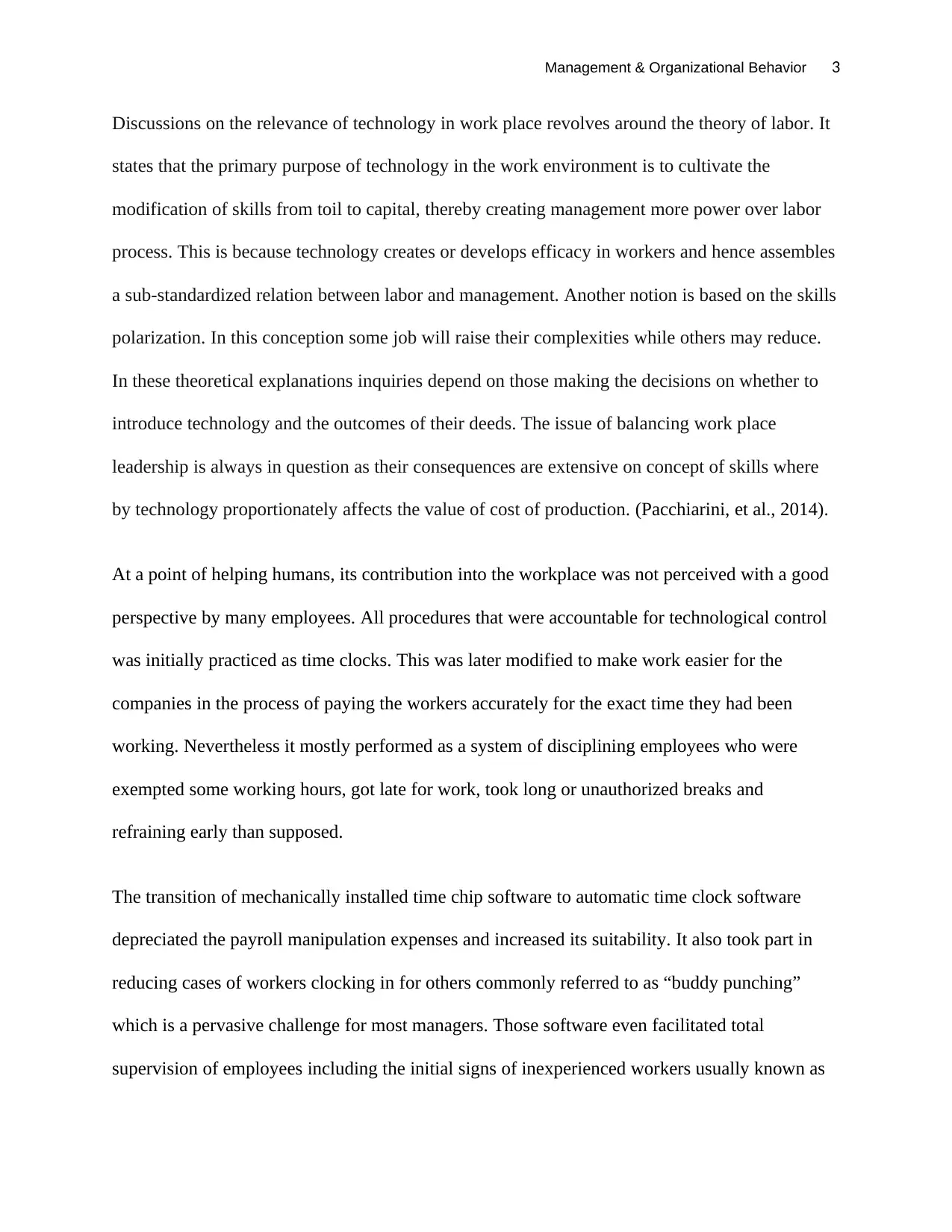
Management & Organizational Behavior 3
Discussions on the relevance of technology in work place revolves around the theory of labor. It
states that the primary purpose of technology in the work environment is to cultivate the
modification of skills from toil to capital, thereby creating management more power over labor
process. This is because technology creates or develops efficacy in workers and hence assembles
a sub-standardized relation between labor and management. Another notion is based on the skills
polarization. In this conception some job will raise their complexities while others may reduce.
In these theoretical explanations inquiries depend on those making the decisions on whether to
introduce technology and the outcomes of their deeds. The issue of balancing work place
leadership is always in question as their consequences are extensive on concept of skills where
by technology proportionately affects the value of cost of production. (Pacchiarini, et al., 2014).
At a point of helping humans, its contribution into the workplace was not perceived with a good
perspective by many employees. All procedures that were accountable for technological control
was initially practiced as time clocks. This was later modified to make work easier for the
companies in the process of paying the workers accurately for the exact time they had been
working. Nevertheless it mostly performed as a system of disciplining employees who were
exempted some working hours, got late for work, took long or unauthorized breaks and
refraining early than supposed.
The transition of mechanically installed time chip software to automatic time clock software
depreciated the payroll manipulation expenses and increased its suitability. It also took part in
reducing cases of workers clocking in for others commonly referred to as “buddy punching”
which is a pervasive challenge for most managers. Those software even facilitated total
supervision of employees including the initial signs of inexperienced workers usually known as
Discussions on the relevance of technology in work place revolves around the theory of labor. It
states that the primary purpose of technology in the work environment is to cultivate the
modification of skills from toil to capital, thereby creating management more power over labor
process. This is because technology creates or develops efficacy in workers and hence assembles
a sub-standardized relation between labor and management. Another notion is based on the skills
polarization. In this conception some job will raise their complexities while others may reduce.
In these theoretical explanations inquiries depend on those making the decisions on whether to
introduce technology and the outcomes of their deeds. The issue of balancing work place
leadership is always in question as their consequences are extensive on concept of skills where
by technology proportionately affects the value of cost of production. (Pacchiarini, et al., 2014).
At a point of helping humans, its contribution into the workplace was not perceived with a good
perspective by many employees. All procedures that were accountable for technological control
was initially practiced as time clocks. This was later modified to make work easier for the
companies in the process of paying the workers accurately for the exact time they had been
working. Nevertheless it mostly performed as a system of disciplining employees who were
exempted some working hours, got late for work, took long or unauthorized breaks and
refraining early than supposed.
The transition of mechanically installed time chip software to automatic time clock software
depreciated the payroll manipulation expenses and increased its suitability. It also took part in
reducing cases of workers clocking in for others commonly referred to as “buddy punching”
which is a pervasive challenge for most managers. Those software even facilitated total
supervision of employees including the initial signs of inexperienced workers usually known as
⊘ This is a preview!⊘
Do you want full access?
Subscribe today to unlock all pages.

Trusted by 1+ million students worldwide
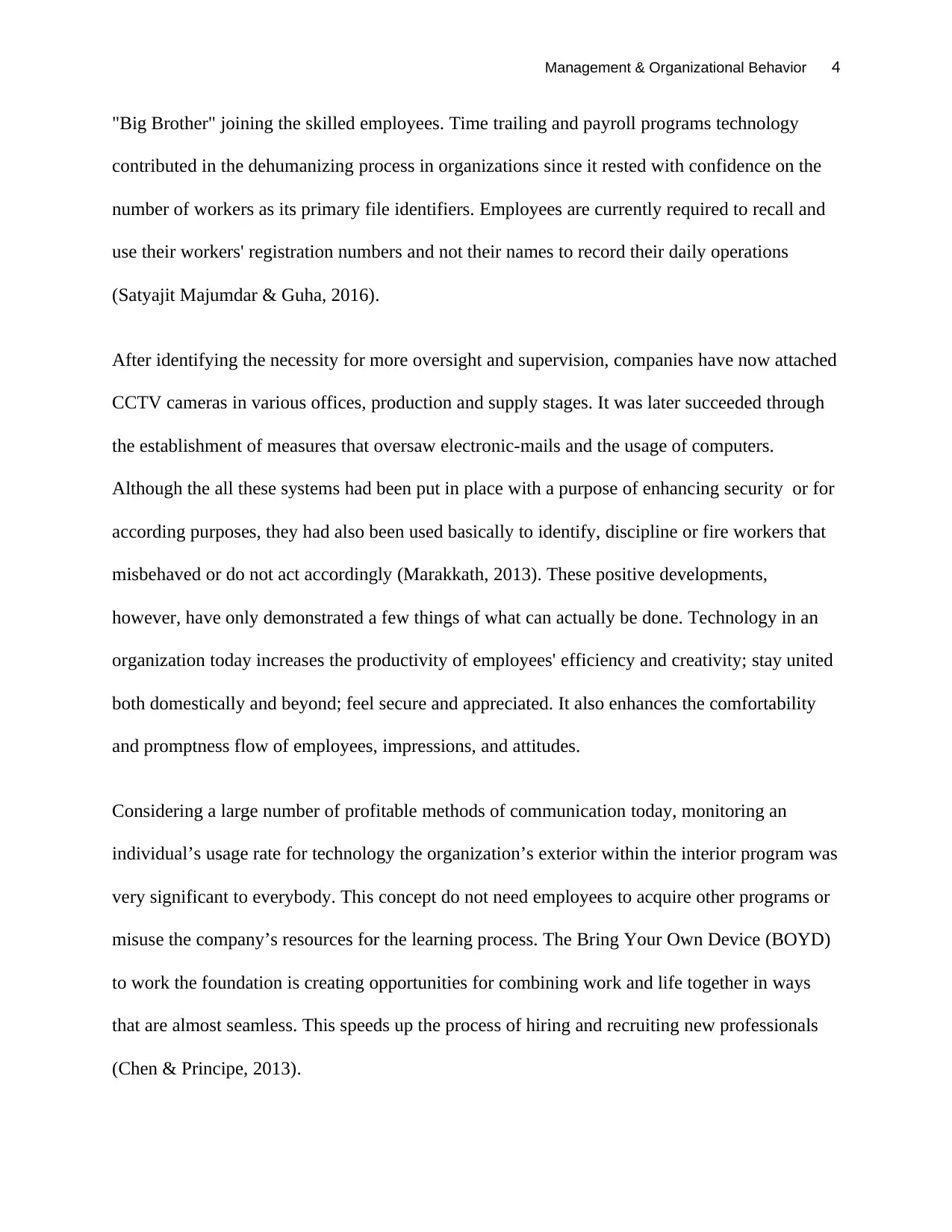
Management & Organizational Behavior 4
"Big Brother" joining the skilled employees. Time trailing and payroll programs technology
contributed in the dehumanizing process in organizations since it rested with confidence on the
number of workers as its primary file identifiers. Employees are currently required to recall and
use their workers' registration numbers and not their names to record their daily operations
(Satyajit Majumdar & Guha, 2016).
After identifying the necessity for more oversight and supervision, companies have now attached
CCTV cameras in various offices, production and supply stages. It was later succeeded through
the establishment of measures that oversaw electronic-mails and the usage of computers.
Although the all these systems had been put in place with a purpose of enhancing security or for
according purposes, they had also been used basically to identify, discipline or fire workers that
misbehaved or do not act accordingly (Marakkath, 2013). These positive developments,
however, have only demonstrated a few things of what can actually be done. Technology in an
organization today increases the productivity of employees' efficiency and creativity; stay united
both domestically and beyond; feel secure and appreciated. It also enhances the comfortability
and promptness flow of employees, impressions, and attitudes.
Considering a large number of profitable methods of communication today, monitoring an
individual’s usage rate for technology the organization’s exterior within the interior program was
very significant to everybody. This concept do not need employees to acquire other programs or
misuse the company’s resources for the learning process. The Bring Your Own Device (BOYD)
to work the foundation is creating opportunities for combining work and life together in ways
that are almost seamless. This speeds up the process of hiring and recruiting new professionals
(Chen & Principe, 2013).
"Big Brother" joining the skilled employees. Time trailing and payroll programs technology
contributed in the dehumanizing process in organizations since it rested with confidence on the
number of workers as its primary file identifiers. Employees are currently required to recall and
use their workers' registration numbers and not their names to record their daily operations
(Satyajit Majumdar & Guha, 2016).
After identifying the necessity for more oversight and supervision, companies have now attached
CCTV cameras in various offices, production and supply stages. It was later succeeded through
the establishment of measures that oversaw electronic-mails and the usage of computers.
Although the all these systems had been put in place with a purpose of enhancing security or for
according purposes, they had also been used basically to identify, discipline or fire workers that
misbehaved or do not act accordingly (Marakkath, 2013). These positive developments,
however, have only demonstrated a few things of what can actually be done. Technology in an
organization today increases the productivity of employees' efficiency and creativity; stay united
both domestically and beyond; feel secure and appreciated. It also enhances the comfortability
and promptness flow of employees, impressions, and attitudes.
Considering a large number of profitable methods of communication today, monitoring an
individual’s usage rate for technology the organization’s exterior within the interior program was
very significant to everybody. This concept do not need employees to acquire other programs or
misuse the company’s resources for the learning process. The Bring Your Own Device (BOYD)
to work the foundation is creating opportunities for combining work and life together in ways
that are almost seamless. This speeds up the process of hiring and recruiting new professionals
(Chen & Principe, 2013).
Paraphrase This Document
Need a fresh take? Get an instant paraphrase of this document with our AI Paraphraser
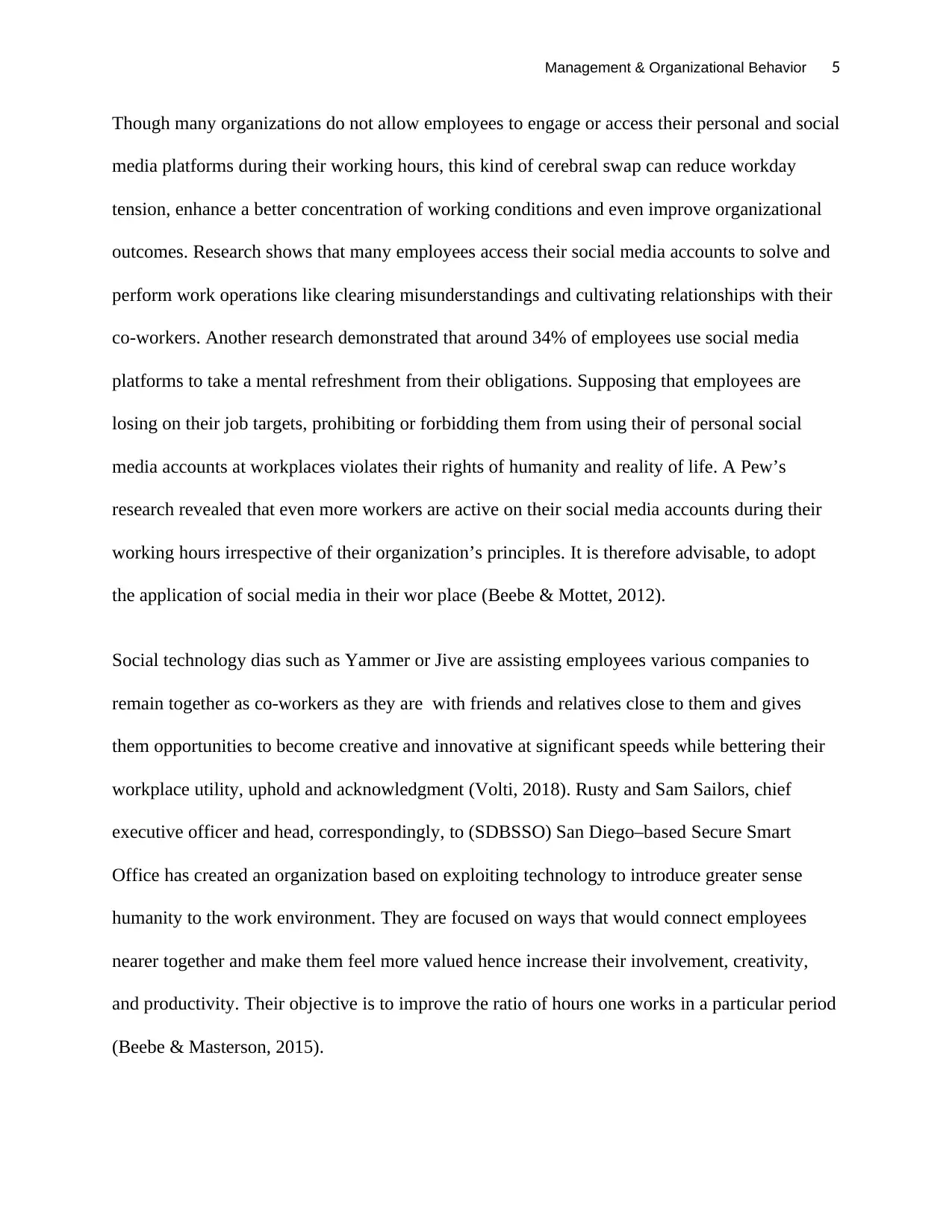
Management & Organizational Behavior 5
Though many organizations do not allow employees to engage or access their personal and social
media platforms during their working hours, this kind of cerebral swap can reduce workday
tension, enhance a better concentration of working conditions and even improve organizational
outcomes. Research shows that many employees access their social media accounts to solve and
perform work operations like clearing misunderstandings and cultivating relationships with their
co-workers. Another research demonstrated that around 34% of employees use social media
platforms to take a mental refreshment from their obligations. Supposing that employees are
losing on their job targets, prohibiting or forbidding them from using their of personal social
media accounts at workplaces violates their rights of humanity and reality of life. A Pew’s
research revealed that even more workers are active on their social media accounts during their
working hours irrespective of their organization’s principles. It is therefore advisable, to adopt
the application of social media in their wor place (Beebe & Mottet, 2012).
Social technology dias such as Yammer or Jive are assisting employees various companies to
remain together as co-workers as they are with friends and relatives close to them and gives
them opportunities to become creative and innovative at significant speeds while bettering their
workplace utility, uphold and acknowledgment (Volti, 2018). Rusty and Sam Sailors, chief
executive officer and head, correspondingly, to (SDBSSO) San Diego–based Secure Smart
Office has created an organization based on exploiting technology to introduce greater sense
humanity to the work environment. They are focused on ways that would connect employees
nearer together and make them feel more valued hence increase their involvement, creativity,
and productivity. Their objective is to improve the ratio of hours one works in a particular period
(Beebe & Masterson, 2015).
Though many organizations do not allow employees to engage or access their personal and social
media platforms during their working hours, this kind of cerebral swap can reduce workday
tension, enhance a better concentration of working conditions and even improve organizational
outcomes. Research shows that many employees access their social media accounts to solve and
perform work operations like clearing misunderstandings and cultivating relationships with their
co-workers. Another research demonstrated that around 34% of employees use social media
platforms to take a mental refreshment from their obligations. Supposing that employees are
losing on their job targets, prohibiting or forbidding them from using their of personal social
media accounts at workplaces violates their rights of humanity and reality of life. A Pew’s
research revealed that even more workers are active on their social media accounts during their
working hours irrespective of their organization’s principles. It is therefore advisable, to adopt
the application of social media in their wor place (Beebe & Mottet, 2012).
Social technology dias such as Yammer or Jive are assisting employees various companies to
remain together as co-workers as they are with friends and relatives close to them and gives
them opportunities to become creative and innovative at significant speeds while bettering their
workplace utility, uphold and acknowledgment (Volti, 2018). Rusty and Sam Sailors, chief
executive officer and head, correspondingly, to (SDBSSO) San Diego–based Secure Smart
Office has created an organization based on exploiting technology to introduce greater sense
humanity to the work environment. They are focused on ways that would connect employees
nearer together and make them feel more valued hence increase their involvement, creativity,
and productivity. Their objective is to improve the ratio of hours one works in a particular period
(Beebe & Masterson, 2015).
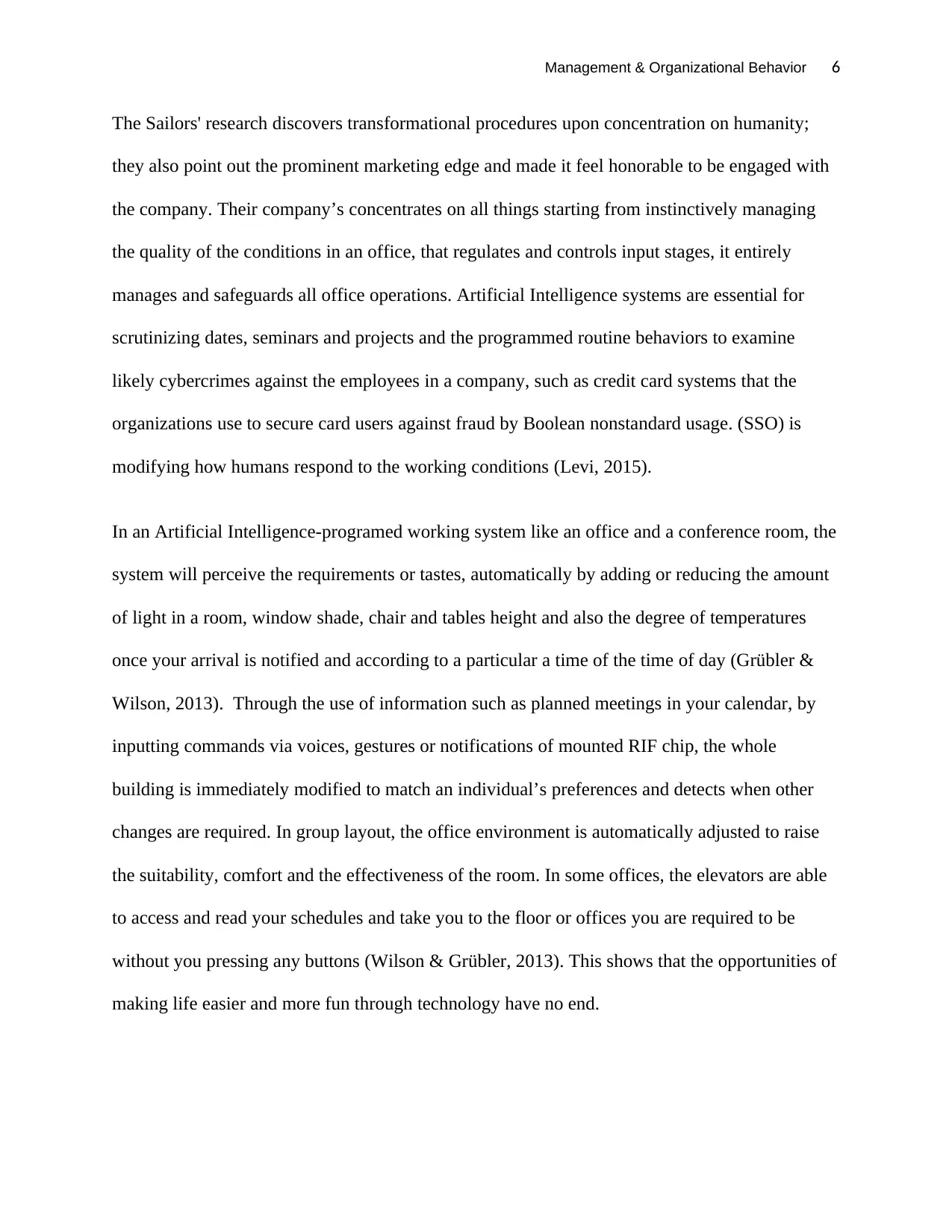
Management & Organizational Behavior 6
The Sailors' research discovers transformational procedures upon concentration on humanity;
they also point out the prominent marketing edge and made it feel honorable to be engaged with
the company. Their company’s concentrates on all things starting from instinctively managing
the quality of the conditions in an office, that regulates and controls input stages, it entirely
manages and safeguards all office operations. Artificial Intelligence systems are essential for
scrutinizing dates, seminars and projects and the programmed routine behaviors to examine
likely cybercrimes against the employees in a company, such as credit card systems that the
organizations use to secure card users against fraud by Boolean nonstandard usage. (SSO) is
modifying how humans respond to the working conditions (Levi, 2015).
In an Artificial Intelligence-programed working system like an office and a conference room, the
system will perceive the requirements or tastes, automatically by adding or reducing the amount
of light in a room, window shade, chair and tables height and also the degree of temperatures
once your arrival is notified and according to a particular a time of the time of day (Grübler &
Wilson, 2013). Through the use of information such as planned meetings in your calendar, by
inputting commands via voices, gestures or notifications of mounted RIF chip, the whole
building is immediately modified to match an individual’s preferences and detects when other
changes are required. In group layout, the office environment is automatically adjusted to raise
the suitability, comfort and the effectiveness of the room. In some offices, the elevators are able
to access and read your schedules and take you to the floor or offices you are required to be
without you pressing any buttons (Wilson & Grübler, 2013). This shows that the opportunities of
making life easier and more fun through technology have no end.
The Sailors' research discovers transformational procedures upon concentration on humanity;
they also point out the prominent marketing edge and made it feel honorable to be engaged with
the company. Their company’s concentrates on all things starting from instinctively managing
the quality of the conditions in an office, that regulates and controls input stages, it entirely
manages and safeguards all office operations. Artificial Intelligence systems are essential for
scrutinizing dates, seminars and projects and the programmed routine behaviors to examine
likely cybercrimes against the employees in a company, such as credit card systems that the
organizations use to secure card users against fraud by Boolean nonstandard usage. (SSO) is
modifying how humans respond to the working conditions (Levi, 2015).
In an Artificial Intelligence-programed working system like an office and a conference room, the
system will perceive the requirements or tastes, automatically by adding or reducing the amount
of light in a room, window shade, chair and tables height and also the degree of temperatures
once your arrival is notified and according to a particular a time of the time of day (Grübler &
Wilson, 2013). Through the use of information such as planned meetings in your calendar, by
inputting commands via voices, gestures or notifications of mounted RIF chip, the whole
building is immediately modified to match an individual’s preferences and detects when other
changes are required. In group layout, the office environment is automatically adjusted to raise
the suitability, comfort and the effectiveness of the room. In some offices, the elevators are able
to access and read your schedules and take you to the floor or offices you are required to be
without you pressing any buttons (Wilson & Grübler, 2013). This shows that the opportunities of
making life easier and more fun through technology have no end.
⊘ This is a preview!⊘
Do you want full access?
Subscribe today to unlock all pages.

Trusted by 1+ million students worldwide
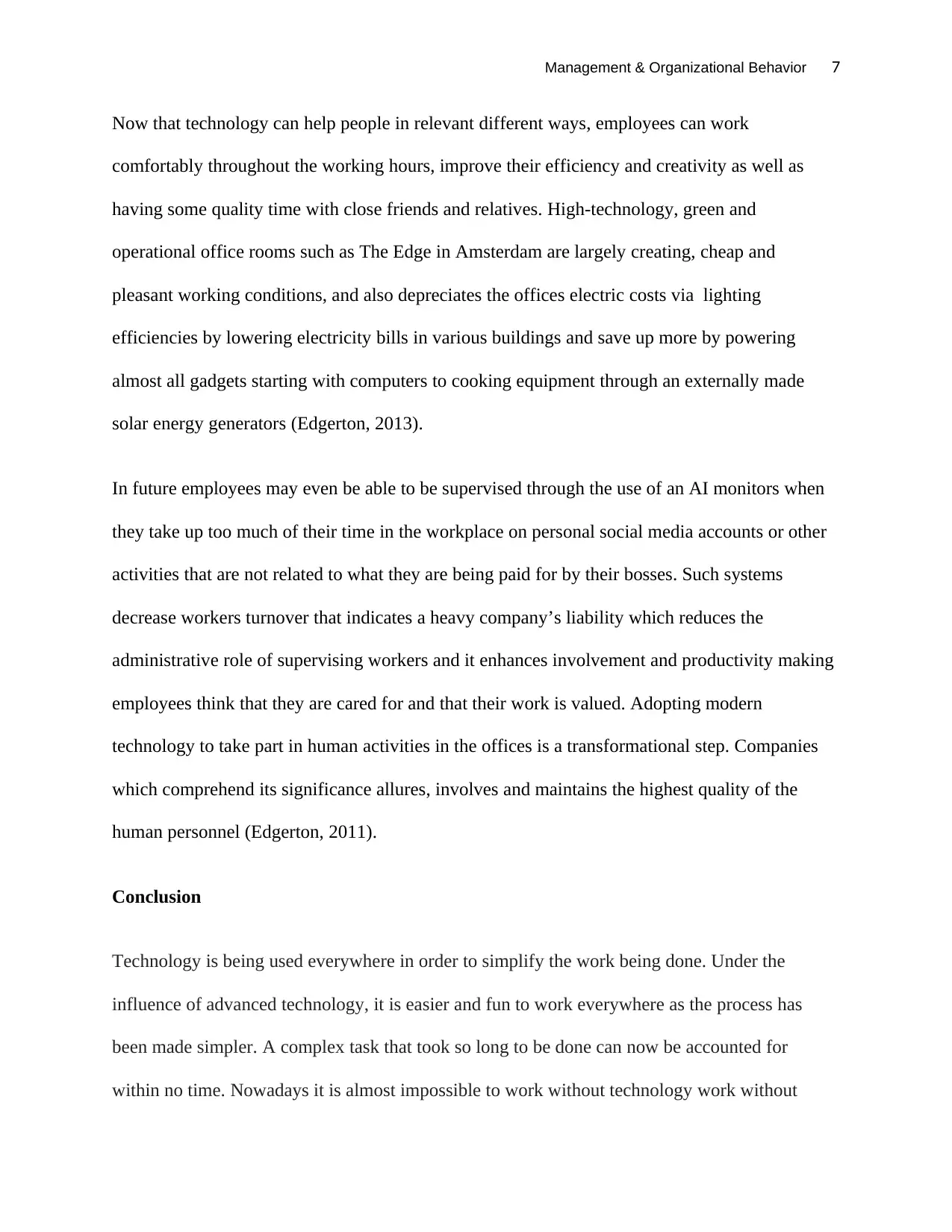
Management & Organizational Behavior 7
Now that technology can help people in relevant different ways, employees can work
comfortably throughout the working hours, improve their efficiency and creativity as well as
having some quality time with close friends and relatives. High-technology, green and
operational office rooms such as The Edge in Amsterdam are largely creating, cheap and
pleasant working conditions, and also depreciates the offices electric costs via lighting
efficiencies by lowering electricity bills in various buildings and save up more by powering
almost all gadgets starting with computers to cooking equipment through an externally made
solar energy generators (Edgerton, 2013).
In future employees may even be able to be supervised through the use of an AI monitors when
they take up too much of their time in the workplace on personal social media accounts or other
activities that are not related to what they are being paid for by their bosses. Such systems
decrease workers turnover that indicates a heavy company’s liability which reduces the
administrative role of supervising workers and it enhances involvement and productivity making
employees think that they are cared for and that their work is valued. Adopting modern
technology to take part in human activities in the offices is a transformational step. Companies
which comprehend its significance allures, involves and maintains the highest quality of the
human personnel (Edgerton, 2011).
Conclusion
Technology is being used everywhere in order to simplify the work being done. Under the
influence of advanced technology, it is easier and fun to work everywhere as the process has
been made simpler. A complex task that took so long to be done can now be accounted for
within no time. Nowadays it is almost impossible to work without technology work without
Now that technology can help people in relevant different ways, employees can work
comfortably throughout the working hours, improve their efficiency and creativity as well as
having some quality time with close friends and relatives. High-technology, green and
operational office rooms such as The Edge in Amsterdam are largely creating, cheap and
pleasant working conditions, and also depreciates the offices electric costs via lighting
efficiencies by lowering electricity bills in various buildings and save up more by powering
almost all gadgets starting with computers to cooking equipment through an externally made
solar energy generators (Edgerton, 2013).
In future employees may even be able to be supervised through the use of an AI monitors when
they take up too much of their time in the workplace on personal social media accounts or other
activities that are not related to what they are being paid for by their bosses. Such systems
decrease workers turnover that indicates a heavy company’s liability which reduces the
administrative role of supervising workers and it enhances involvement and productivity making
employees think that they are cared for and that their work is valued. Adopting modern
technology to take part in human activities in the offices is a transformational step. Companies
which comprehend its significance allures, involves and maintains the highest quality of the
human personnel (Edgerton, 2011).
Conclusion
Technology is being used everywhere in order to simplify the work being done. Under the
influence of advanced technology, it is easier and fun to work everywhere as the process has
been made simpler. A complex task that took so long to be done can now be accounted for
within no time. Nowadays it is almost impossible to work without technology work without
Paraphrase This Document
Need a fresh take? Get an instant paraphrase of this document with our AI Paraphraser
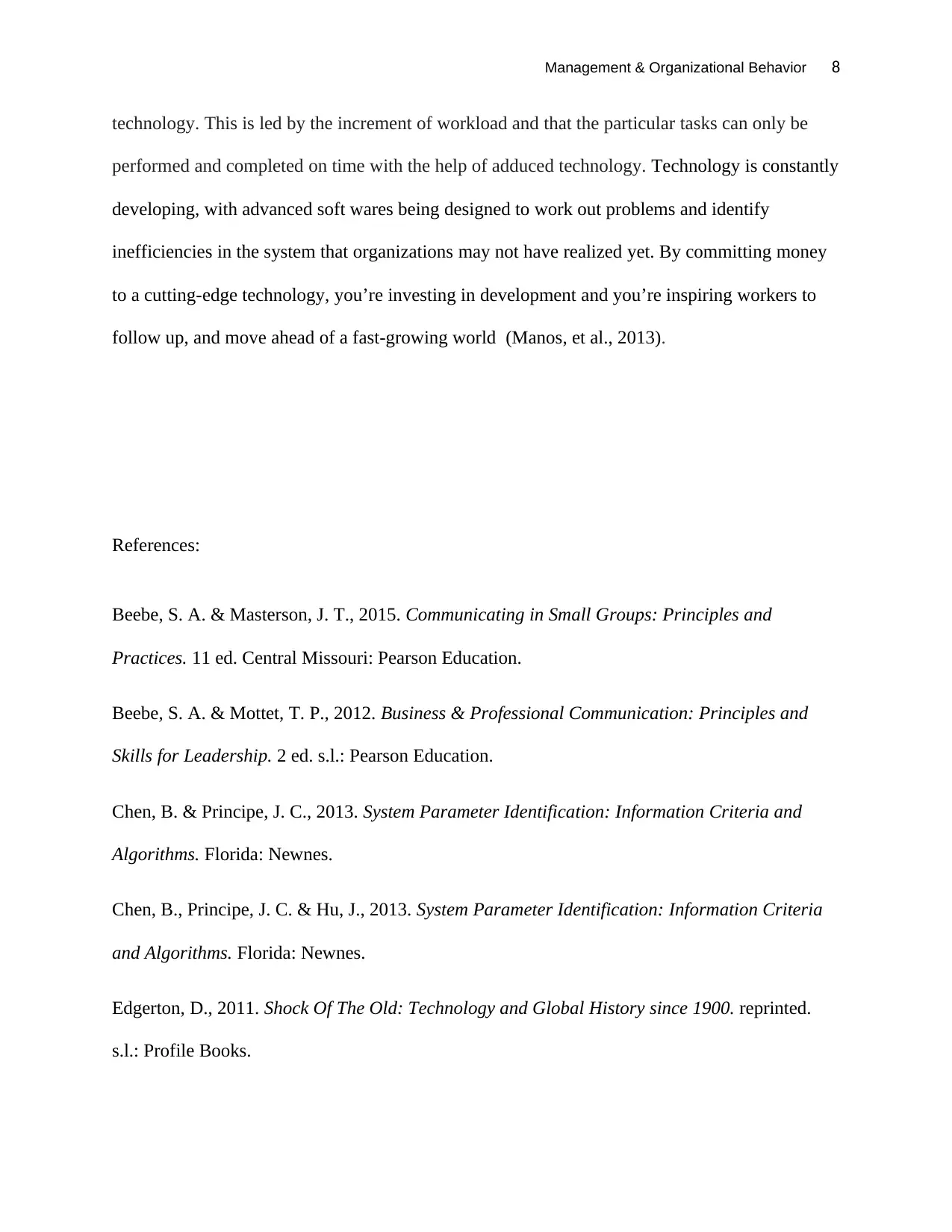
Management & Organizational Behavior 8
technology. This is led by the increment of workload and that the particular tasks can only be
performed and completed on time with the help of adduced technology. Technology is constantly
developing, with advanced soft wares being designed to work out problems and identify
inefficiencies in the system that organizations may not have realized yet. By committing money
to a cutting-edge technology, you’re investing in development and you’re inspiring workers to
follow up, and move ahead of a fast-growing world (Manos, et al., 2013).
References:
Beebe, S. A. & Masterson, J. T., 2015. Communicating in Small Groups: Principles and
Practices. 11 ed. Central Missouri: Pearson Education.
Beebe, S. A. & Mottet, T. P., 2012. Business & Professional Communication: Principles and
Skills for Leadership. 2 ed. s.l.: Pearson Education.
Chen, B. & Principe, J. C., 2013. System Parameter Identification: Information Criteria and
Algorithms. Florida: Newnes.
Chen, B., Principe, J. C. & Hu, J., 2013. System Parameter Identification: Information Criteria
and Algorithms. Florida: Newnes.
Edgerton, D., 2011. Shock Of The Old: Technology and Global History since 1900. reprinted.
s.l.: Profile Books.
technology. This is led by the increment of workload and that the particular tasks can only be
performed and completed on time with the help of adduced technology. Technology is constantly
developing, with advanced soft wares being designed to work out problems and identify
inefficiencies in the system that organizations may not have realized yet. By committing money
to a cutting-edge technology, you’re investing in development and you’re inspiring workers to
follow up, and move ahead of a fast-growing world (Manos, et al., 2013).
References:
Beebe, S. A. & Masterson, J. T., 2015. Communicating in Small Groups: Principles and
Practices. 11 ed. Central Missouri: Pearson Education.
Beebe, S. A. & Mottet, T. P., 2012. Business & Professional Communication: Principles and
Skills for Leadership. 2 ed. s.l.: Pearson Education.
Chen, B. & Principe, J. C., 2013. System Parameter Identification: Information Criteria and
Algorithms. Florida: Newnes.
Chen, B., Principe, J. C. & Hu, J., 2013. System Parameter Identification: Information Criteria
and Algorithms. Florida: Newnes.
Edgerton, D., 2011. Shock Of The Old: Technology and Global History since 1900. reprinted.
s.l.: Profile Books.
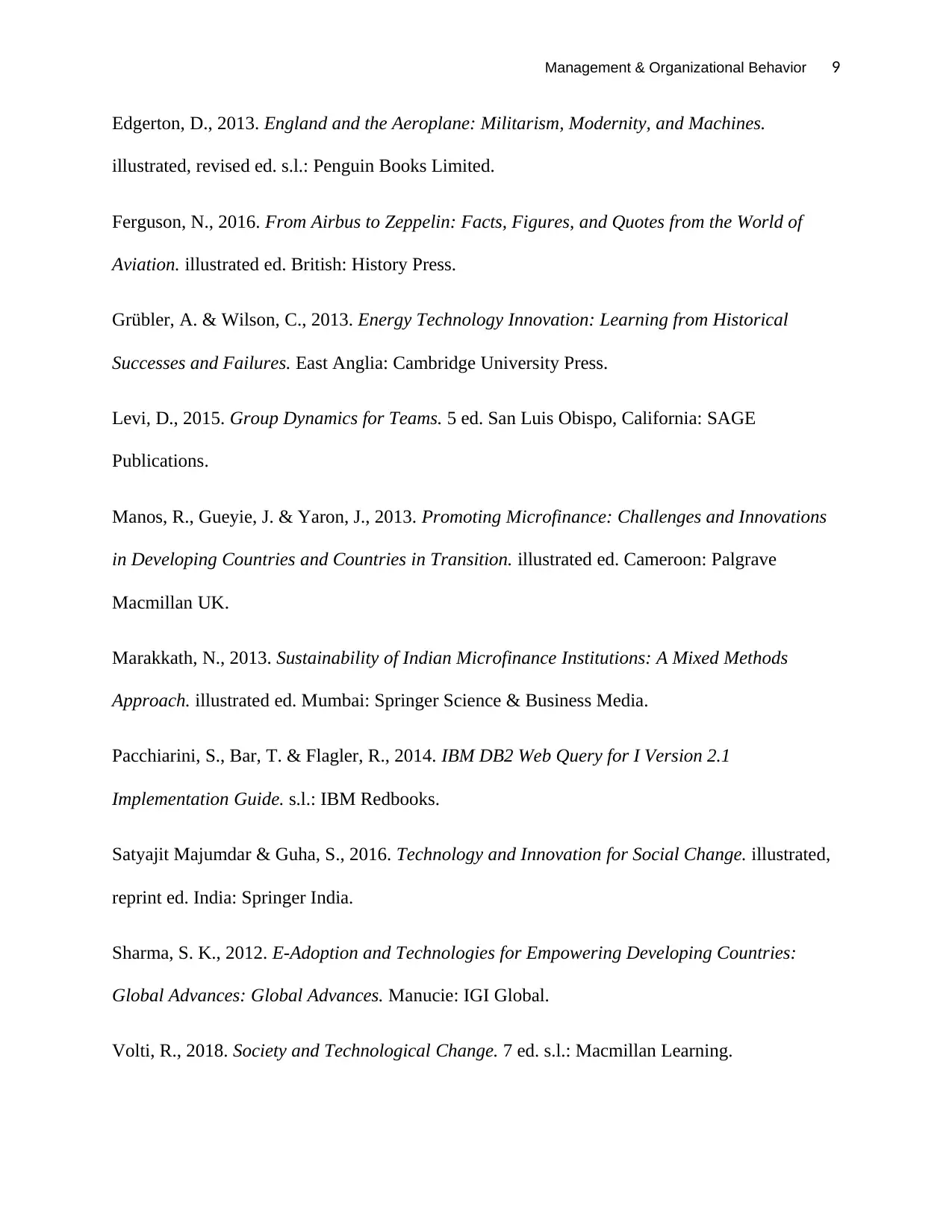
Management & Organizational Behavior 9
Edgerton, D., 2013. England and the Aeroplane: Militarism, Modernity, and Machines.
illustrated, revised ed. s.l.: Penguin Books Limited.
Ferguson, N., 2016. From Airbus to Zeppelin: Facts, Figures, and Quotes from the World of
Aviation. illustrated ed. British: History Press.
Grübler, A. & Wilson, C., 2013. Energy Technology Innovation: Learning from Historical
Successes and Failures. East Anglia: Cambridge University Press.
Levi, D., 2015. Group Dynamics for Teams. 5 ed. San Luis Obispo, California: SAGE
Publications.
Manos, R., Gueyie, J. & Yaron, J., 2013. Promoting Microfinance: Challenges and Innovations
in Developing Countries and Countries in Transition. illustrated ed. Cameroon: Palgrave
Macmillan UK.
Marakkath, N., 2013. Sustainability of Indian Microfinance Institutions: A Mixed Methods
Approach. illustrated ed. Mumbai: Springer Science & Business Media.
Pacchiarini, S., Bar, T. & Flagler, R., 2014. IBM DB2 Web Query for I Version 2.1
Implementation Guide. s.l.: IBM Redbooks.
Satyajit Majumdar & Guha, S., 2016. Technology and Innovation for Social Change. illustrated,
reprint ed. India: Springer India.
Sharma, S. K., 2012. E-Adoption and Technologies for Empowering Developing Countries:
Global Advances: Global Advances. Manucie: IGI Global.
Volti, R., 2018. Society and Technological Change. 7 ed. s.l.: Macmillan Learning.
Edgerton, D., 2013. England and the Aeroplane: Militarism, Modernity, and Machines.
illustrated, revised ed. s.l.: Penguin Books Limited.
Ferguson, N., 2016. From Airbus to Zeppelin: Facts, Figures, and Quotes from the World of
Aviation. illustrated ed. British: History Press.
Grübler, A. & Wilson, C., 2013. Energy Technology Innovation: Learning from Historical
Successes and Failures. East Anglia: Cambridge University Press.
Levi, D., 2015. Group Dynamics for Teams. 5 ed. San Luis Obispo, California: SAGE
Publications.
Manos, R., Gueyie, J. & Yaron, J., 2013. Promoting Microfinance: Challenges and Innovations
in Developing Countries and Countries in Transition. illustrated ed. Cameroon: Palgrave
Macmillan UK.
Marakkath, N., 2013. Sustainability of Indian Microfinance Institutions: A Mixed Methods
Approach. illustrated ed. Mumbai: Springer Science & Business Media.
Pacchiarini, S., Bar, T. & Flagler, R., 2014. IBM DB2 Web Query for I Version 2.1
Implementation Guide. s.l.: IBM Redbooks.
Satyajit Majumdar & Guha, S., 2016. Technology and Innovation for Social Change. illustrated,
reprint ed. India: Springer India.
Sharma, S. K., 2012. E-Adoption and Technologies for Empowering Developing Countries:
Global Advances: Global Advances. Manucie: IGI Global.
Volti, R., 2018. Society and Technological Change. 7 ed. s.l.: Macmillan Learning.
⊘ This is a preview!⊘
Do you want full access?
Subscribe today to unlock all pages.

Trusted by 1+ million students worldwide
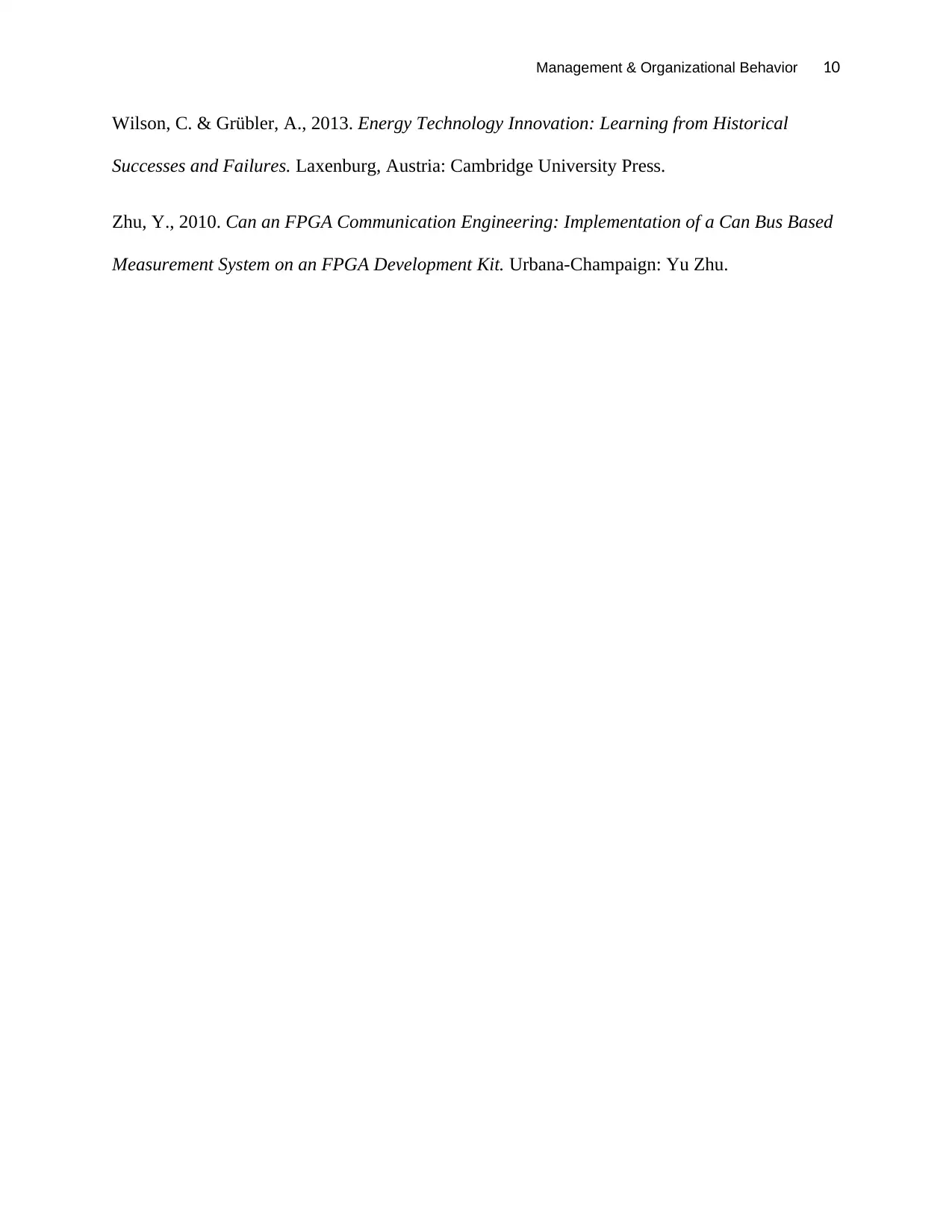
Management & Organizational Behavior 10
Wilson, C. & Grübler, A., 2013. Energy Technology Innovation: Learning from Historical
Successes and Failures. Laxenburg, Austria: Cambridge University Press.
Zhu, Y., 2010. Can an FPGA Communication Engineering: Implementation of a Can Bus Based
Measurement System on an FPGA Development Kit. Urbana-Champaign: Yu Zhu.
Wilson, C. & Grübler, A., 2013. Energy Technology Innovation: Learning from Historical
Successes and Failures. Laxenburg, Austria: Cambridge University Press.
Zhu, Y., 2010. Can an FPGA Communication Engineering: Implementation of a Can Bus Based
Measurement System on an FPGA Development Kit. Urbana-Champaign: Yu Zhu.
1 out of 10
Related Documents
Your All-in-One AI-Powered Toolkit for Academic Success.
+13062052269
info@desklib.com
Available 24*7 on WhatsApp / Email
![[object Object]](/_next/static/media/star-bottom.7253800d.svg)
Unlock your academic potential
Copyright © 2020–2025 A2Z Services. All Rights Reserved. Developed and managed by ZUCOL.





